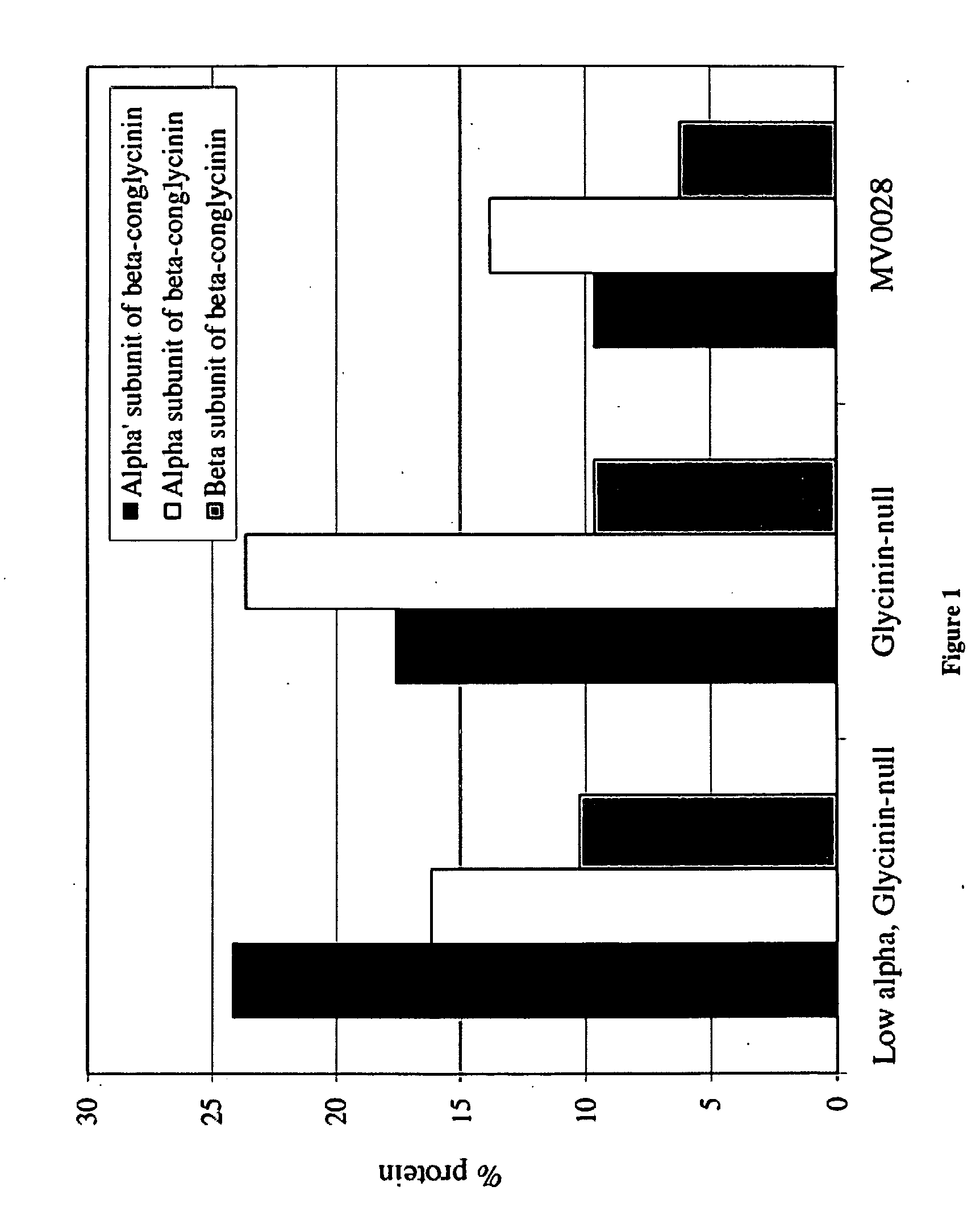Increased alpha-prime beta-conglycinin soybeans
a beta-conglycinin, soybean technology, applied in the field of plant breeding and molecular biology, can solve the problems of difficult identification of individuals that are genetically superior, difficult recovery of molecular tools simultaneously, and difficult identification of transgressive segregates or superior genotypes with the traits of interest, etc., to achieve the effect of improving yield, reducing toxicity, and reducing toxicity
- Summary
- Abstract
- Description
- Claims
- Application Information
AI Technical Summary
Benefits of technology
Problems solved by technology
Method used
Image
Examples
example 1
Soybean Varieties with Increased α′-Subunit Content
[0109]The relative percentages of α′, α, and β subunits in the β-conglycinin trimer are ˜35, 45, and 20%, respectively (Maruyama et al., 1999). The ratio of α:α′ is approximately 1.28 in most seeds. Commercial varieties were screened for increased α′-subunit content. Protein analysis was carried out as follows: soybean seeds from a single variety were pooled and ground using the CAT Mega-Grinder (SOP Asci-01-0002). Ground samples were stored at 4° C. For analysis, ˜30 mg of flour from each was weighed into one well of a 96 well 2 ml microtiter plate. Protein was extracted for 1 hour with shaking in 1.0 ml 1× Laemmli SDS buffer pH 6.8 containing 0.1M dithiothreitol (DTT) as a reductant. Following centrifugation, a portion of each extract was further diluted in SDS buffer to yield 0.2-0.5 μg / μL total protein, heated to 90-100° C. for 10 min, and cooled. For each sample, 1-2 μg total protein was loaded using a 12 channel pipet onto a 2...
example 2
Source of Increased α′-Subunit Content in Commercial Varieties
[0111]After screening commercial varieties for increased α′-subunit content, variety with a seed α:α′ ratio of less than 1 was selected for future breeding efforts. In addition, the lineage of each variety was evaluated. Eighty percent of the screened varieties with PI88788 in their background had a α:α′ ratio less than 1 (Table 1). Additionally, 100% of the screened varieties with a α:α′ ratio less than 1 had PI88788 in their background. Hence, breeders can pre-select varieties for increased α′-subunit by evaluating the pedigree of varieties for PI88788. Protein analysis is needed to verify phenotype, but the pre-selection could reduce the number of plants in an initial screening effort.
example 3
Combination of Glycinin-Null and Increased α′-Subunit Trait Further Increases α′-Subunit Content in Seed
[0112]Glycinin genes have a direct impact on β-conglycinin content in soybean seeds. Soybean plants with mutations conferring reduced Gy1, Gy2, Gy3, Gy4 and Gy5 protein content have increased β-conglycinin and subsequently increased α′-subunit content in seed. For example, typical soybeans contain around 40% glycinin, 20% β-conglycinin, with the α′-subunit accounting for 9% of total protein. However, increased β-conglycinin soybeans contain, for example, less than 40%, 30%, 20%, or 6% glycinin, and greater than 20%, 30% or 40% β-conglycinin. The mutant soybean plants with mutations conferring reduced glycinin content and increased β-conglycinin content are referred to as glycinin nulls.
[0113]Crosses were generated between glycinin null plants derived from B2G2 and plants identified with increased α′-subunit trait. The progeny was screened for protein content including relative per...
PUM
| Property | Measurement | Unit |
|---|---|---|
| pH | aaaaa | aaaaa |
| Sodium Dodecyl Sulfate PolyAcrylamide Gel Electrophoresis | aaaaa | aaaaa |
| capillary electrophoresis | aaaaa | aaaaa |
Abstract
Description
Claims
Application Information
 Login to View More
Login to View More - R&D
- Intellectual Property
- Life Sciences
- Materials
- Tech Scout
- Unparalleled Data Quality
- Higher Quality Content
- 60% Fewer Hallucinations
Browse by: Latest US Patents, China's latest patents, Technical Efficacy Thesaurus, Application Domain, Technology Topic, Popular Technical Reports.
© 2025 PatSnap. All rights reserved.Legal|Privacy policy|Modern Slavery Act Transparency Statement|Sitemap|About US| Contact US: help@patsnap.com

